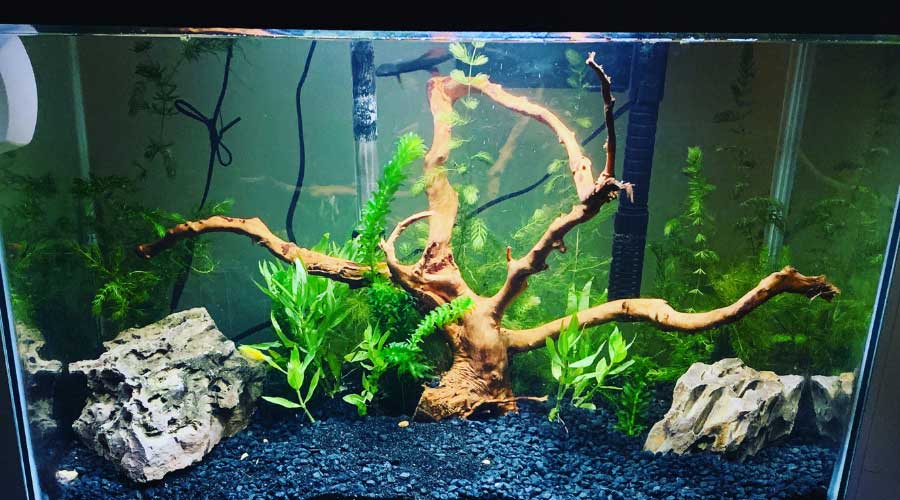In this blog, we are going to discuss easy aquarium plants. You’ll learn why plants are great for your aquarium, and you will learn about different types of aquarium plants.
No freshwater fish tank is complete without some live plants. Far more than mere decoration, they can help with the health and vitality of your fish and make your life as a fish tank owner much easier.
Table of Contents:
- Why Plants are Good for Your Fish Tank
- Fish Health
- Additional Nourishment
- Oxygenating the Water
- Reducing Algae
- Easy Aquarium Plants: Great Picks
- Hornwort
- Anubias
- Java Moss
- Java Fern
- Water Trumpets
- Water Wisteria
- Duckweed
- Caring for Your Aquarium Plants
- Substrate
- Lighting
- Fertilizer
- Aquascaping
- Maintaining a Clean Tank
- Easy Aquarium Plants: A Recap
Why Plants are Good for Your Fish Tank
Live plants offer many benefits to freshwater fish tanks, not the least of which is their aesthetic value. Like the fish you choose to populate your tank, the live plants you choose for the foreground, mid-ground, and background of their habitat are pleasing to look at. One of the main benefits of having a fish tank, to begin with.
Live plants add another layer of living beauty to any aquarium that plastic plants and decorations simply can’t match. Aquatic plants come in an exotic array of shapes, colors, and sizes to suit any visual preferences, and the way they move about in the water, their leaves and stems swaying gently, is soothing to the body and mind. The aesthetic benefits of placing live plants in your freshwater fish tank are far from its only benefits, however.
Fish Health
Aquatic plants actually help the fish in your tank to stay healthier. While fake plants are made from materials that won’t harm your tank, those materials degrade over time, and, when they do, the chemicals they release into the water as a result of that process most certainly can impact your tank’s water quality. Moreover, if a fish consumes a piece of an artificial plant, whether a new plant or degraded remains, it can harm the fish’s digestive tract and make the fish ill or, even kill it.
The right live aquatic plants, by contrast, not only avert these risks but provide positive benefits to fish health as well. Live aquatic plants help the water in fish tanks to achieve the right nutrient balance, utilizing nutrients that can harm your fish in excessive quantities and releasing nutrients that can promote healthy fish. In addition, live plants can serve as hiding places for small fish attempting to avoid their larger predatory tank-mates.
Additional Nourishment
When the fish in your tank needs some extra nutrition, if they have a live plant to nibble on, they will obtain that nourishment themselves. You need not worry about your fish destroying your plants this way, either, as long as you feed them regularly. Fish will only nibble on live plants now and again, and only in small enough quantities to get their immediate nutritional needs met. As most fish are omnivorous, they may even require a small bite of a live plant now and then in their diet. Live plants can also benefit fish digestion.
Oxygenating the Water
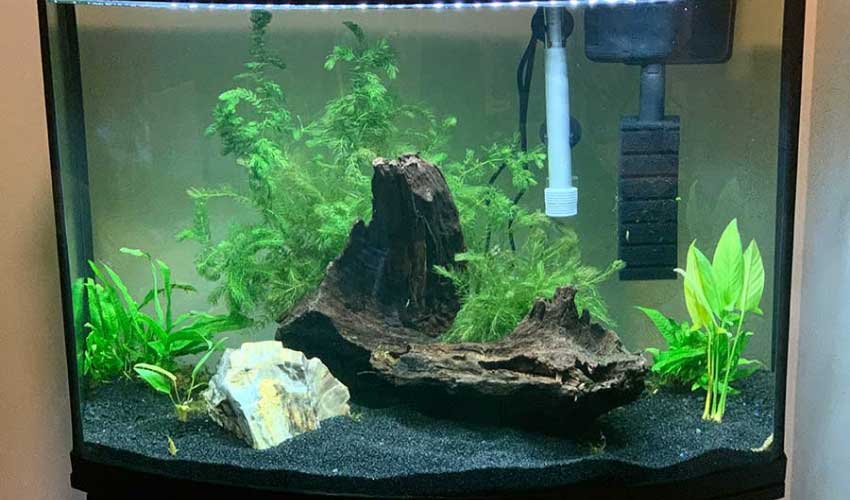
Through the process of photosynthesis, plants consume CO2 and release O2 as a byproduct into the water. Fish need O2 to survive, and they release CO2 as waste that can harm them if it builds up in excess in their water. Even though your fish tank will undoubtedly have a pump that oxygenates the water, that is frequently insufficient to produce all the oxygen your fish require. Air stones can provide additional oxygenation, but they are also prone to attracting bacteria, causing your water to get dirtier faster, harming your fish, and requiring you to clean the tank more frequently. Real plants can substitute for both an air pump and air stone.
Reducing Algae
Algae is a common and prevalent problem for all fish tank owners. Chances are all the chemicals you add to your water will still fail to prevent this insidious plant from proliferating. Populating your tank with algae eaters can certainly help keep algae down to a degree, but they can hardly be expected to keep a tank completely clean of algae. Live aquatic plants, by contrast, consume the same nutrients as algae but, thanks to their roots, more efficiently, thereby depriving algae of sufficient nourishment to thrive.
Easy Aquarium Plants: Some of the Best Picks
Now that you know the many benefits of aquatic plants, it’s time to pick the ones most suitable for your tank. In many ways, the best plants for your fish tank are the ones you like the best, as in large part, it’s simply a matter of personal preference. There are, however, certain matters of care, compatibility, uses, and requirements to consider that make some plants better choices for certain aquariums than others.
Now let’s look at a sampling of some of the most popular and easy aquarium plants to care for.
Hornwort (Ceratophyllum demursum)
Native to the rivers of New Zealand, hornwort is a prolific plant with dark green leaves that can provide dense, thick camouflage for your smaller fish. You can grow hornwort as a floating plant or root it in your fish tank substrate. Either way, you’ll find it incredibly hardy and a fast grower.
Over time, hornwort will shed its leaves, which some fish will then use as a food source. If your hornwort sheds too many leaves for your fish to keep up with, you can always skim them off of the surface with a net.
Additionally, you can trim these plants, bundle them up, and place them in other places throughout the tank. To to do this, simply trim off several stems of your hornwort plant, and secure the bottom of the stems with a weighted plant fastener.
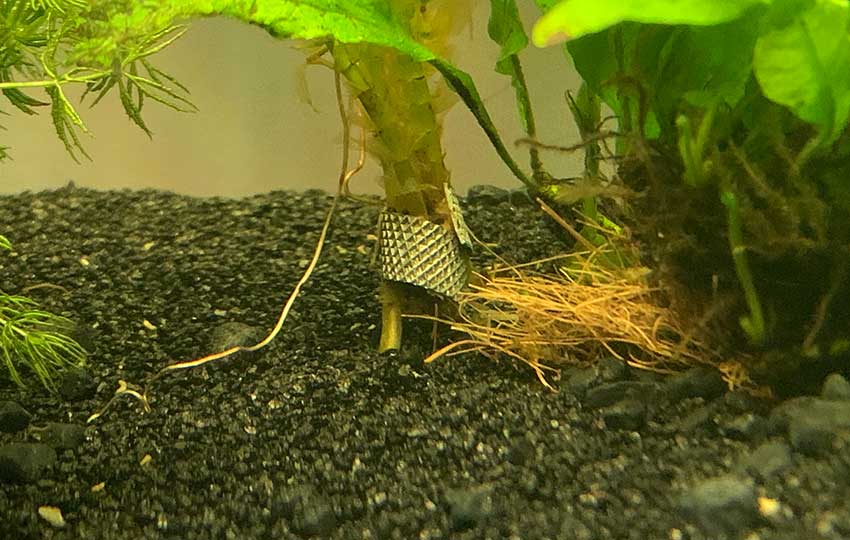
Hornwort is one of several easy aquarium plants that can be great addition to your tank. They can instantly add depth and color to your tank and require minimal care.
Anubias (Anubia Nana)
Producing thick, hardy dark green leaves, anubias is a plant good for placing prominently in the foreground of your tank. So hardy are their leaves, they can even withstand fish like algae eaters and plecostomus that like to attach themselves to their surface.
Anubias prefers moderate light levels and can tolerate a range of temperatures, though it prefers between 72 and 82 degrees Fahrenheit.
If you place anubias near or on top of any rocks or driftwood structures in your tank, it will attach itself and spread across its surface. Although you can grow anubias fully or partially submerged, be sure not to bury the rhizomes beneath your tank’s substrate. It’s fine, however, if the rhizomes cling to any wooden structures or rocks in your tank.
To propagate your own anubias, simply separate the side shoots or divide the rhizome. Be sure to remove leaves that die off or detach from the plant as soon as you notice them, as they will quickly rot and get sucked into the filter, producing an unfortunate mess.
Java Moss (Taxiphyllum barbieri)
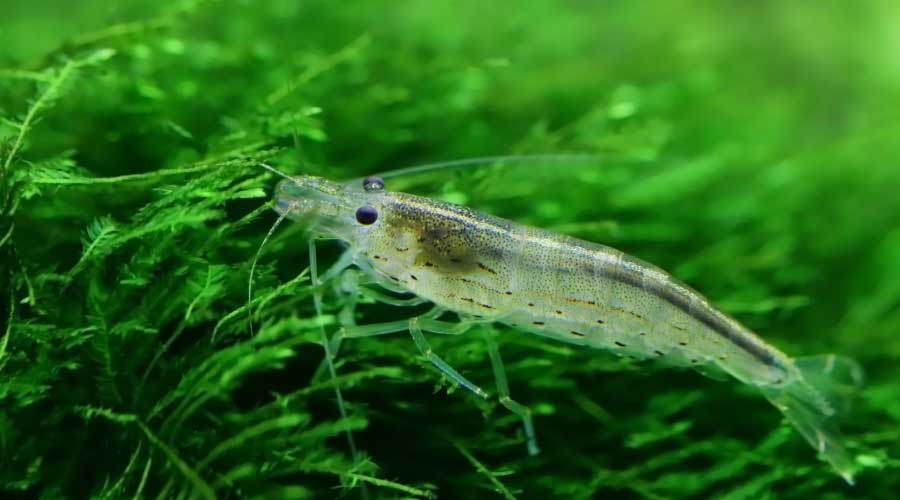
A native Southeast Asian plant, including Vietnam, Singapore, Philippines, Malaysia, Japan, Indonesia, and, of course, Java, Java moss clings to driftwood and rocks both above and below the water’s surface. It features bright green oval-shaped, elongated leaves and thrives in temperatures between 70 and 75 degrees Fahrenheit, though it can tolerate waters up to 85 or 90 degrees.
In addition to its visual appeal, Java moss can also provide sustenance and protection to newly-forming fry and give shelter to shrimp and other smaller fish. Java moss will rapidly form a carpet over wood or any sandy substrate you might use in your tank. To encourage this process, you can use rubber bands to hold the roots to the desired surface, then remove the bands after two to four weeks, once the roots have taken hold on their own.
Java Fern
Distinct from Java moss, Java fern grows along the freshwater stream- and river banks in Southeast Asian countries like China, India, Malaysia, and Thailand, so, if you’re looking to emulate the look and feel of an Amazon river bed, such as in an aquarium with cichlids, java ferns are a natural choice. Preferring water temperatures of 68 to 82 degrees Fahrenheit, a pH level of 6.0 to 7.5, and low-to-moderate lighting, Java ferns feature a thick, stick-like base that you must ensure remains above your tank’s substrates or it will deteriorate and die. The plant’s leaves produce pods that can propagate into new Java ferns. Fish don’t generally eat Java ferns, helping them to last longer.
Water Trumpets (Cryptocoryne Beckettii)
Native to Sri Lanka, the water trumpet is a lovely mid-ground aquatic plant often sold as a foreground plant despite that its leaves grow up to between four and six inches. They produce dark brown leaves with violet on the underside, though the shades of these can vary greatly depending on the conditions of your tank.
Water trumpets prefer moderate lighting and, in fact, avoid giving them lighting that’s too strong, lest it discolors or, worse, burn their leaves. They prefer water that’s slightly alkaline, with a pH of between 5.5 and 8. More important than maintaining a particular temperature for these plants is maintaining a relatively consistent temperature, as they can tolerate most temperature conditions as long as they don’t rapidly or significantly change. This is a slow-growing plant that can take many weeks for the roots to take hold firmly, though, once they do, these plants are easy to keep alive, even in particularly hard water. Water trumpets prefer a mixed substrate that combines fine gravel with plant soil.
Water Wisteria (Hygrophila difformis)
A background aquarium plant that’s easy to care for, water wisteria produces bushy, bright green leaves that fish commonly use for shelter and safety. Growing between 15 and 20 inches tall and 10 to 11 inches wide, water wisterias like a pH of 6.5 to 7.5 and a water temperature of 74 to 82 degrees Fahrenheit. This plant requires very little care to thrive, although, if left unmanicured, it can overrun the tank and block too much light.
Duckweed (Spirodela polyrhiza)
A floating plant with delicate-looking leaves, the hardiness of this plant that’s also known as Bayroot and Water Lens may surprise you. Preferring natural and moderate lighting, duckweed spreads fast and offers abundant shelter for surface-dwellers and young fish. Certain fish species even use duckweed as a breeding ground.
While duckweed is easy to care for, you may find it a bit too easy, as it spreads rapidly and can overrun your tank if you don’t regularly trim it back. If duckweed winds up covering the entire surface of your tank, as it will do if left to its own devices, it can deprive the water of oxygen, harming the fish and other plants living there. In addition to absorbing nutrients from the water, however, duckweed also absorbs some toxins, making the water for the fish and other plants cleaner. Duckweed thrives best in tanks with minimal water movement, especially near the surface.
Caring for Your Aquarium Plants
When adding live plants to your fish tank, remember that healthy plants translate to healthy fish. Therefore, if you add live plants into your aquarium environment, be prepared to care for them properly to keep them, and your fish, healthy.
Choose the Right Substrate
Proper care of any aquarium plant starts with planting it in the correct substrate for that plant’s optimal growth. While freshwater aquatic plants can generally grow in whatever aquatic substrate you use, the best one for live plants starts with a base layer of 2-3 inches of laterite. This is a rock and soil combo rich in aluminum and iron. Then, add on top of that an inch of gravel or some other larger substrate (the right substrate for your tank may vary based on your aquatic life).
If you aren’t using laterite, make sure to provide sufficient fish-safe plant-food additives, fertilizers, and iron supplements. Adding CO2 can benefit certain aquatic plants as well.
When planting potted aquatic plants, you can promote better root development by removing them from their containers and planting them into the substrate directly.
Provide the Right Lighting
You’re probably well aware that, for photosynthesis to occur, terrestrial plants require light, and aquatic plants are no different. How much light a plant needs, aquatic plants included, depends on the particular plant.
Full-spectrum lighting promotes optimal growth in most aquatic plants, and most plants prefer 10-12 hours of light each day. Not all aquatic plants meet these criteria, however, so learn about the specific needs of any aquatic plant before you purchase it and place it in your tank.
Some examples of freshwater aquarium plants with specific light needs include:
- Bamboo (Dracaena sanderiana) – Prefers medium to high lighting
- Bolbitis – Needs at least medium lighting
- Echinodorus – Generally thrives in low to medium light
Of course, the best way to make caring for your aquarium plants as easy as possible is to choose the right plants for your tank and its inhabitants, as well as your lifestyle.
Use the Right Fertilizer
To promote overall plant growth and vitality, add an iron-based, fish-safe fertilizer to your tank after each cleaning.
Aquascape Regularly
While it can be fun and rewarding to watch your plants grow and thrive, be careful not to let them get out of control, as that can be detrimental to the plants as well as the other life forms growing in your tank, blocking out invaluable light the other plants and your fish require. To avoid letting your plants get too big, prune them as necessary. How often you’ll need to do this will depend on your choice of plants. Some aquatic plants, like tall Rotala Indica, will overtake the entire surface of your aquarium if you’re not careful. Other plants will require no pruning at all.
In addition, remove any decaying and dead leaves and plant matter from your tank as soon as you spot them, as they can negatively impact the water quality in the aquarium.
Also, depending on the type of fish you keep, some of them might have no problem munching on decaying plant matter. So, it’s actually not a bad idea to have a few fish that serve as a clean-up crew.
Maintain a Clean Tank and Keep Water Quality High
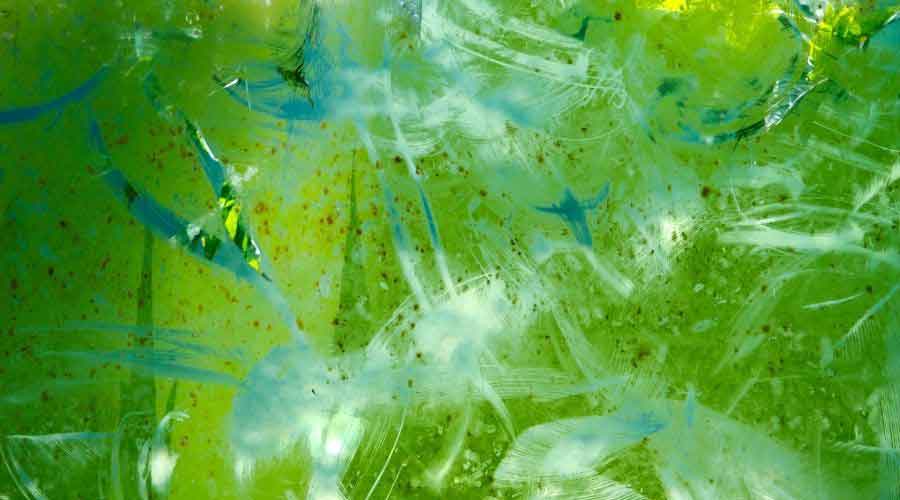
A clean tank and good water quality work hand-in-hand to keep your aquatic plants healthy, each helping to support the other.
You can use an appropriate fish tank cleaner to clean your aquarium regularly, but even more importantly for the health of your aquatic plants is to keep algae growth under control.
Algae and your aquatic plants will compete for the same nutrients and light. Simply using an algaecide, however, may harm the aquatic plants you’re trying to protect as much as it does the algae you’re trying to get rid of. Consider, instead, adding herbivorous fish to your tank that will eat the algae but not your aquatic plants. Plecos are great for cleaning algae in a tank. But, before placing any fish in your tank, always remember to check the compatibility with the other fish you are keeping.
You can also physically remove excess algae from the aquarium walls with an algae scraper and should plan on doing this once each week to support the health of your aquatic plants.
As for water quality, aquatic plants tend to prefer a pH level of between 6.5 and 7.8, though some aquatic plants may differ, their requirements exceeding either end of these extremes. Check the pH level of your tank regularly to ensure you maintain a pH level that supports both the plants and fish that live there.
Easy Aquarium Plants: A Recap
Choosing the right aquatic plants for your fish tank is a matter of considering many factors, including compatibility with the other life in your tank and their growing requirements. On the other hand, choosing whether to add aquatic plants to your tank at all requires nothing but the realization that they will inevitably make your fish happier and healthier.
Caring for these new life forms doesn’t need to be an added chore, since there are plenty of easy aquarium plants to choose from, some so easy to care for that they actually help make caring for your aquarium in other ways a whole lot easier.

